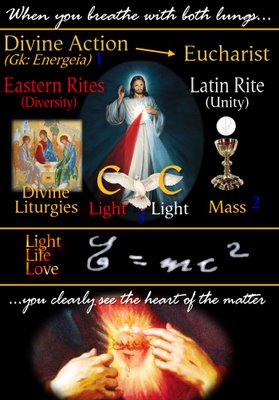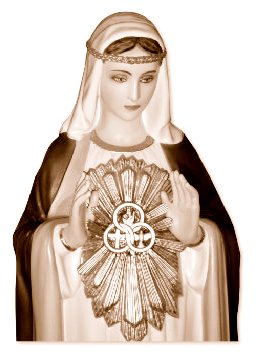More LIGHT from the EAST...Time and Eternity and Einstein
 J.M.J. + O.B.T. + M.G.R.*
J.M.J. + O.B.T. + M.G.R.*Fr. Theodore Heckman
Upbeat
v.1, n.6, 1968
Let us begin with scientific time. Time, along with the whole of observed reality, received a revolutionary turn of understanding with the emergence of Einstein’s Theory of Relativity. Before this, the nature of time was considered as an independent reality dealing with the occurrence of succeeding events. A train sets out in one city and arrives at its destination in another. Between the two events of departure and arrival there is an interval of time. The problem then becomes simply one of measurement, and that means first of all agreeing on a standard unit of time to which every other segment can be referred. Once this has been agreed upon, i.e., that the fundamental unit of time should be the second having a universally-agreed upon length, the rest of the problem of time is a matter of multiplying that unit into larger segments or dividing it according to specific needs.
Exactly how long the fundamental unit is to be has only recently undergone a certain change. The standard of determination previously was set according to the rotation of the earth on its axis. That rotation, however, was found not to be constant; resulting measurements were then slightly inaccurate. A new, more consistent determination was agreed upon, this time defined by the revolution of the earth around the sun. This newly defined time unit was after 1956 adopted in scientific work where precision is necessary, while the former standard remains in civil use.
In any case, the Twentieth Century witnessed a much more startling revolution in the realm of time with the appearance of the Theory of Relativity. What came into question was the notion that time has an independent, objective reality. The revolution which Einstein had begun said emphatically, No. Neither time nor space could be considered independently any more; in the words of Minkowski, each one in itself “sinks to a mere shadow.” It is no longer possible to speak of one without the other; both form a unified reality since in all observations they appear together. Every event is an event in space and in time; thus the three special dimensions and the fourth dimension, time, must always be considered together. Events so considered take place in what is termed the time-space continuum.
The key to the discovery of the inseparable connection, or better, the single reality of the four-dimensional continuum was found in the analysis of the concept of simultaneity. Einstein did not believe that one could call two events apparently taking place at the same time simultaneous if they were distant to each other. When he compared (mathematically) the time of one system to that of a second apparently ‘simultaneous’ system, the second one being in motion, he found a difference. Further, he found this difference to be dependent upon the velocity of the system in motion, so that even the difference was not constant, but varied according to velocity. The one constant which remained was the velocity of light. To put the problem in more concrete terms: as a moving object increases its velocity significantly, when compared to a similar stationary object, all other factors being equal, the time of the former slows down in relation to the time of the latter. The difference becomes more marked as the moving object approaches the speed of light. An observer moving with the moving object would not, however, notice a difference. The difference, to repeat, is seen only in relation to a stationary or comparatively stationary object. What then happens at the velocity of light itself? The answer must be—the moving object would enter infinity.
If time thus has no absolute or objective quality, but is ultimately relational, it seems that our normal, day-to-day considerations of time (and space) are nothing more than tools of convenience which assist us in relating apparently simultaneous and successive events in a limited and meaningful way. But there is nothing absolute in them. This understanding, Einstein believed, may be one clue to man’s discovery of his own basic freedom; the human creature may not be so confined and limited as he once supposed.
We turn now to the notion of time as understood by the Church. Orthodox Christianity has always considered its central concern to be the Kingdom of God. Everything in the Church is related to this: Christ brought the Kingdom to earth in His Person and opened the way for men to enter it; the Eucharist is the Food of the Kingdom, the Liturgy is the banquet; liturgical music is the taste of the divine harmony of the Kingdom; icons are the presence of the saints who now rest in the Kingdom. Everything refers to the Kingdom, and the Kingdom gives everything meaning. The time of the Kingdom, as we all know, is eternity. Christ came to bring us eternal life. Strangely, or perhaps not so strangely, when Christ describes eternal life it is not in terms of time at all.
In his “High Priestly Prayer” (John 17), He says: And this is life eternal, that they might know you, the only true God and Him whom you sent, Jesus Christ.
Eternity is here described in terms of knowledge. There is not even a hint of time.
Now the gift of eternal life is given not at one’s physical death, but rather at Baptism which normally comes at the beginning of one’s physical life. So the Christian who is aware of the meaning of his Baptism is able to consider himself and indeed is already living in eternity, beyond time, in the knowledge and presence of God and His Son, Jesus Christ.
The Orthodox Church lives, in other words, in the New Age, the aeon. Each time we pray, “Thine is the Kingdom, the power, and the glory, to ages of ages,” we are attesting to something not of the future, but already existing of which we are a part, the eternity which is now. If this seems too fantastic and unreal, let us keep in mind that even physically it would be possible to enter infinity, providing one could build a space vehicle to travel the speed of light.
One final question remains; what, then, is the relation of this eternity to what we normally call time? Maximus the Confessor, in discussing the nature of time, along with the properties of all other created things, sees the basis and origin of the sensible world in the phenomenon of change. Time, whose nature it is to begin, continue, and to end, implies at every step, change. The two realities of time and change of necessity require one another. (Compare this to the time-motion connection of modern science). Beyond the realm of time, there is the ‘aeon,” which Maximus describes as “motionless time, while time is the aeon measured according to motion.” Here then is the proper understand of the two realms and their relationship. The realm of the aeon is defined by rest and is immeasurable; the realm of time is that same aeon but defined by motion and measurement. This idea is exciting not only because it shows the coincidence of time and eternity, but because it approximates so closely the discoveries of modern science. The intuitions of a Seventh-Century Byzantine theologian and the intricately precise theories of Twentieth-Century intellects converge.
It is likely, therefore, that the latter half of the present century will witness the general convergence of two avenues of understanding, the one scientific and theoretical, the other religious and intuitional. One evidence is already here in the common acceptance of time as an eternal present, measured for convenience, but not ultimately confining. The step beyond that is very short: to acknowledge that the freedom of eternity is a gift from God both to men and to the whole universe.
the Holy Eucharist, the REAL PRESENCE, i.e.,
knowledge of Jesus Christ IS the New Age
and this is the REAL Gift of Holy Mass.
of the God-Man and the Church He estabished on this earth is rubbish.
for pointing this key fact out to us.
"An error in the beginning is an error indeed." St. Thomas Aquinas
Mike Rizzio, SOLT
Imitate Mary
Become like Jesus
Live for the Triune God
Seek the Light of Our Lord Jesus Christ
See you on the High Ground!
If you have a few minutes please go to the following sites
and see what I have been compelled to work on since 2004.
http://soltlaity.org/breadoflife.htm
http://soltlaity.org/slideshow.htm
I will attempt to answer any and all inquiries at jmjriz@aol.com.
O Beata Trinitas; St. Michael, St. Gabriel and St. Raphael





























No comments:
Post a Comment